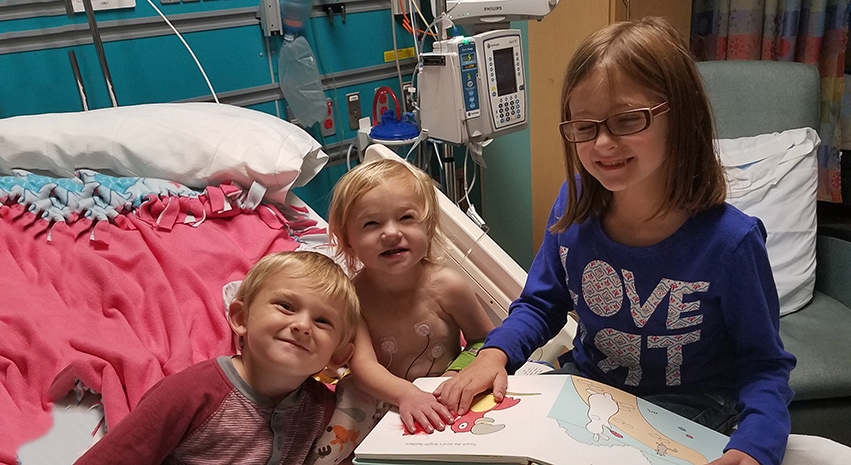Amy was 32 weeks pregnant when she was sent for a maternal-fetal consultation. Something concerning had shown up on her ultrasound, but she and her husband Jason weren’t worried. They had already had two healthy pregnancies, and this one seemed no different.
“We were really hoping things would be fine, and we could grab a quick date-night snack before picking up our kids at daycare and school,” Amy says. “Within an hour, we were at OSF HealthCare Children’s Hospital of Illinois sitting down with a pediatric cardiologist, and he explained to us a diagnosis we had never heard of before.”
Their daughter, whom they would name Hannah, had heterotaxy—a rare condition that affects how the child’s internal organs, including her heart, were forming. “We were in shock,” Amy recalls. “It just seemed so surreal because we had had two seemingly normal, healthy pregnancies. And then they are telling me she might need multiple heart surgeries in her first year of life.”
A Unique Arrangement of Organs
Nearly five years later, Amy and Jason are well-versed in the list of things that makes Hannah’s body one-of-a-kind—a “unique arrangement of organs,” Amy calls it. Due to her heterotaxy, Hannah’s liver is unusually placed, and she has two right-shaped lungs. She also has intestinal malrotation, which means her intestines are abnormally twisted, and she was born without a spleen.
But doctors were most concerned about Hannah’s heart. She had complex congenital heart disease, including holes in both the upper and lower chambers of her heart. “They were thinking within six to nine months—maybe a year—she would be needing major surgery,” Jason explains.
Hannah had her first heart surgery at just three weeks old when her oxygen levels unexpectedly dropped. Surgeons installed a Blalock-Taussig (BT) shunt, a small tube to create a pathway for blood to go from the heart to the lungs. “That’s when we got to know all the doctors and all the pediatric ICU nurses, because that hospital stay was four weeks,” Amy recalls.
But Hannah’s heart journey was just beginning. Due to the complexity of her heart defects, she would sooner or later need a major repair.
A Life-Saving Surgery
Knowing their child was facing a difficult journey, Jason and Amy decided to seek second opinions with other congenital heart programs. “We wanted to see the bigger picture,” Jason explains. Hannah had two congenital defects that would potentially be addressed: atrial septal defect (ASD), which is a hole between the top two chambers of the heart, and ventricular septal defect (VSD), a hole between the lower chambers.
As they were searching for a surgical solution, Hannah’s parents and doctors would need to determine whether only one of the holes could be closed or if surgeons could close both, giving Hannah a four-chambered heart. The doctors at OSF Children’s Hospital encouraged the family to look at all the options available, sharing their imaging and consulting with teams from other health systems. They even built a 3D model of Hannah’s heart to help visualize her unique anatomy.
OSF Children’s Hospital, in partnership with the Advanced Imaging and Modeling (AIM) Lab, developed a way to turn 2D images (as seen on a traditional MRI) into 3D images that can be printed into an exact physical model of a patient’s heart. The couple still has their plaster copy of Hannah’s heart at their home in Washington, Illinois.
Taking this imaging technology to another level, Hannah’s team was able to view that 3D model in virtual reality, so her surgeon, Dr. Mark Plunkett, could not just see, but interact with Hannah’s heart, allowing him to lay out a surgical plan that would provide the outcome her parents hoped for.
Moving to Normalcy
Hannah had her bi-ventricle repair in November 2018 when she was 2½ years old. After four weeks in the hospital, she recovered and now has an active life. While she will continue to face challenges, she will face them with loving parents and a team of healthcare professionals committed to giving her a full and healthy life.
“We really trust our team,” Amy says. “We have handed our baby over to them many times for her surgeries, and they have been able to give her an amazing life. She goes to pre-school and the babysitters, and she’s living a normal four-year-old’s life right now.”
Connecting with other parents has been an important part of Amy and Jason’s support system, whether local organizations like T.O.U.C.H. or through Facebook and online groups. “I just want other families to have hope that their child can survive and live a healthy life with heart defects,” Amy says. “I want them to know that there are places they can reach out to for support. They are not alone on this journey.”PM




